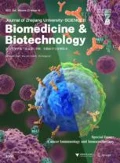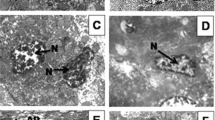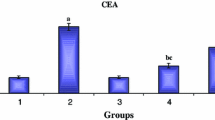Abstract
Chlorella vulgaris (CV) has been reported to have antioxidant and anticancer properties. We evaluated the effect of CV on apoptotic regulator protein expression in liver cancer-induced rats. Male Wistar rats (200∼250 g) were divided into eight groups: control group (normal diet), CDE group (choline deficient diet supplemented with ethionine in drinking water to induce hepatocarcinogenesis), CV groups with three different doses of CV (50, 150, and 300 mg/kg body weight), and CDE groups treated with different doses of CV (50, 150, and 300 mg/kg body weight). Rats were sacrificed at various weeks and liver tissues were embedded in paraffin blocks for immunohistochemistry studies. CV, at increasing doses, decreased the expression of anti-apoptotic protein, Bcl-2, but increased the expression of pro-apoptotic protein, caspase 8, in CDE rats, which was correlated with decreased hepatoctyes proliferation and increased apoptosis as determined by bromodeoxy-uridine (BrdU) labeling and terminal deoxynucleotidyl transferase mediated dUTP nick-end labeling (TUNEL) assay, respectively. Our study shows that CV has definite chemopreventive effect by inducing apoptosis via decreasing the expression of Bcl-2 and increasing the expression of caspase 8 in hepatocarcinogenesis-induced rats.
Similar content being viewed by others
References
Akhurst, B., Croager, E.J., Farley-Roche, C.A., Ong, J.K., Dumble, M.L., Knight, B., Yeoh, G.C., 2001. A modified choline-deficient, ethionine-supplemented diet protocol effectively induces oval cells in mouse liver. Hepatology, 34(3):519–522. [doi:10.1053/jhep.2001.26751]
Coultas, L., Strasser, A., 2003. The role of the Bcl-2 protein family in cancer. Semin. Cancer. Biol., 13(2):115–123. [doi:10.1016/S1044-579X(02)00129-3]
Crawford, R.A., Caldwell, C., Iles, R.K., Shepherd, J.H., Chard, T., 1998. Prognostic significance of the Bcl-2 apoptotic family of proteins in primary and recurrent cervical cancer. Br. J. Cancer, 78(2):210–214.
Davies, R.A., Knight, B., Tian, Y.W., Yeoh, G.C., Olynyk, J.K., 2006. Hepatic oval cell response to the cholinedeficient, ethionine supplemented model of murine liver injury is attenuated by the administration of a cyclooxygenase 2 inhibitor. Carcinogenesis, 27(8):1607–1616. [doi:10.1093/carcin/bgi365]
Hanson, C.J., Bootman, M.D., Distelhorst, C.W., Maraldi, T., Roderick, H.L., 2008. The cellular concentration of Bcl-2 determines its pro- or anti-apoptotic effect. Cell Calcium., 44(3):243–258. [doi:10.1016/j.ceca.2007.11.014]
Haperin, S.A., Smith, B., Nolan, C., Shay, J., Kralovec, J., 2003. Safety and immunoenhancing effect of a Chlorelladerived dietary supplement in healthy adults undergoing influenza vaccination: randomized, double-blind, placebocontrolled trial. CMAJ, 162(2):111–117.
Hasegawa, T., Noda, K., Kumamoto, S., Ando, Y., Yamada, A., Yoshikai, Y., 2000. Chlorella vulgaris culture supernatant (CVS) reduces psychological stress-induced apoptosis in thymocytes of mice. Int. J. Immunopharmacol., 22(11):877–885. [doi:10.1016/S0192-0561(00)00049-7]
Hopkins-Donaldson, S., Bodmer, J.L., Bourloud, K.B., Brognara, C.B., Tschopp, J., Gross, N., 2000. Loss of caspase-8 expression in neuroblastoma is related to malignancy and resistance to TRAIL-induced apoptosis. Med. Pediatr. Oncol., 35(6):608–611. [doi:10.1002/1096-911X(20001201)35:6〈608::AID-MPO25〉3.0.CO;2-U]
Kew, M.C., 2002. Epidemiology of hepatocellular carcinoma. Toxicology, 181–182:35–38. [doi:10.1016/S0300-483X(02)00251-2]
Lampe, J.W., 2003. Spicing up a vegetarian diet: chemopreventive effects of phytochemicals. Am. J. Clin. Nutr., 78(Suppl. 3):579S–583S.
Lowes, K.N., Croager, E.J., Olynyk, J.K., Abraham, L.J., Yeoh, G.C., 2003. Oval cell-mediated liver regeneration: role of cytokines and growth factors. J. Gastroenterol. Hepatol., 18(1):4–12. [doi:10.1046/j.1440-1746.2003.02906.x]
Md Saad, S., Mohd Yusof, Y.A., Wan Ngah, W.Z., 2006. Comparison between locally produced Chlorella vulgaris and Chlorella vulgaris from Japan on proliferation and apoptosis of liver cancer cell line, HepG2. Malaysian J. Biochem. & Molec. Biol., 13(1):32–36.
Miyao, M., Shinoda, H., Takahashi, S., 2006. Caspase-3, caspase-8 and nuclear factor-kappaB expression in human cholesteatoma. Otology & Neurotology, 27(1):8–13. [doi:10.1097/01.mao.0000180482.34545.b8]
National Cancer Registry of Malaysia, 2003. Cancer Incidence of Malaysia 2002. Available at http://www.crc.gov.my
Okuda, K., 2000. Hepatocellular carcinoma. J. Hepatol., 32(Suppl. 1):225–237. [doi:10.1016/S0168-8278(00)80428-6]
Park, J.W., 2005. Hepatocellular carcinoma in Korea: introduction and overview. Korean J. Gastroenterol., 45(4):217–226.
Sano, T., Tanaka, Y., 1987. Effect of dried, powdered Chlorella vulgaris on experimental atherosclerosis and alimentary hypercholestrolemia in cholesterol-fed rabbits. Artery, 14(2):76–84.
Schafer, D.F., Sorrell, M.F., 1999. Hepatocellular carcinoma. Lancet, 353(9160):1253–1257. [doi:10.1016/S0140-6736(98)09148-X]
Sulaiman, S., Wan Ngah, W.Z., Shamaan, N.A., Mohd Yusof, Y.A., 2006. Chemopreventive effect of Chlorella vulgaris on liver cancer induced rats. Int. J. Cancer Res., 2(3):234–241.
Surh, Y.J., 1999. Molecular mechanisms of chemopreventive effects of selected dietary and medical phenolic substances. Mutation Res., 428(1-2):305–327.
Surh, Y.J., 2002. Anti-tumor promoting potential of selected spice ingredients with antioxidative and anti-inflammatory activities: a short review. Food Chem. Toxicol., 40(8):1091–1097. [doi:10.1016/S0278-6915(02)00037-6]
Tee, L.B.G., Kirilak, Y., Huang, W.H., Morgan, R.H., Yeoh, G.C., 1994. Differentiation of oval cells into duct-like cells in preneoplastic liver of rats placed on a choline-deficient diet supplemented with ethionine. Carcinogenesis, 15(12):2747–2756. [doi:10.1093/carcin/15.12.2747]
Yuspa, S.H., Poirier, M.C., 1988. Chemical carcinogenesis: from animal models to molecular models in one decade. Adv. Cancer Res., 50:25–68. [doi:10.1016/S0065-230X(08)60434-0]
Author information
Authors and Affiliations
Corresponding author
Additional information
Project supported by Department of Biochemistry, Faculty of Medicine, UKM Medical Center, Universiti Kebangsaan Malaysia, and the Malaysian Ministry of Science and Technological Innovation (MOSTI)
Rights and permissions
About this article
Cite this article
Mohd Azamai, E.S., Sulaiman, S., Mohd Habib, S.H. et al. Chlorella vulgaris triggers apoptosis in hepatocarcinogenesis-induced rats. J. Zhejiang Univ. Sci. B 10, 14–21 (2009). https://doi.org/10.1631/jzus.B0820168
Received:
Accepted:
Published:
Issue Date:
DOI: https://doi.org/10.1631/jzus.B0820168




